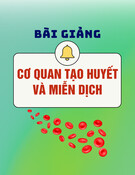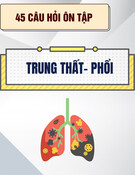
HUE JOURNAL OF MEDICINE AND PHARMACY ISSN 1859-3836
20
Hue Journal of Medicine and Pharmacy, Volume 14, No.2-2024
Evaluating of the effect of low-level laser therapy on wound healing in
rabbits
Nguyen Thi Bich Phuong1*, Nguyen Ngoc Tuan1, Dinh Van Han1, Nguyen Nhu Lam1,
Nguyen Thi Huong1, Le Thi Hong Hanh2, Tran Quoc Tien3, Tong Quang Cong3*
(1) Le Huu Trac National Burn Hospital
(2) Vietnam Military Medical University
(3) Institute of Materials Science
Vietnamese Academy of Science and Technology, Hanoi, Vietnam
Abstract
Background: A large number of studies have demonstrated the wound-healing effects of LLLT in vitro, in
animal models, and in clinical practice. However, there are also differences in the study results, which are
dose and wavelength dependent of LLLT. Objective: Evaluation of the wound healing process in experimental
animals treated with low- level laser therapy in clinical and histopathology. Subjects and Methods: Prospective
study on 30 rabbits, each rabbit created two full thickness of 2R = 4 cm wounds on both sides of the back:
wound A (treated with LLLT, 780 nm, 3 J/cm2 with 72 s irradiation time, 1 time per day), wound B (control: no
laser). Wounds are bandaged and laser irradiated once a day according to the procedure until the lesion is
completely epithelialized. Wound biopsy was taken at: before treatment (D0), after 7 days (D7), after 14 days
(D14) of treatment. Monitor and evaluate progress at the local wound. Results: The area and speed of wound
narrowing on the side of the laser site narrowed faster than the control side (p < 0.05). The results of rabbit
skin histopathology showed that the number of inflammatory cells on the laser side decreased significantly
compared with the non-laser side (p(D14) < 0.05), while the number of neovascular and fibroblasts increased
rapidly on the LLLT side when compared with the control side (p(D7) < 0.05). Conclusions: LLLT (780 nm, dose
3J/cm2) increased wound healing in experimental rabbit model. LLLT promotes wound narrowing, reduces
inflammation, stimulates angiogenesis, and increases collagen synthesis fibroblasts.
Keywords: low-level laser therapy, wound healing, experimental animals, histopathology.
Corresponding author: Tong Quang Cong; Email: congtq2004@gmail.com
Nguyen Thi Bich Phuong. Email: bsphuongvbqg@gmail.com
Recieved: 11/8/2023; Accepted: 19/2/2024; Published: 25/2/2024
DOI: 10.34071/jmp.2024.2.3
1. INTRODUCTION
Since the 1960s, the efficacy of low-level laser
therapy (LLLT) in wound treatment has been
reported. Adre Mester, a Hungarian physicist, was
the first to study the biological effectiveness of
LLLT. Numerous reports have been published over
the past few decades, demonstrating the positive
effects of low-level laser therapy (LLLT) in in vitro, in
vivo, and clinical studies [1,2,3]. The results of these
studies have varied. The wavelength mainly used
for phototherapy is from the red to near-infrared
region corresponding to the optical window of 600
nm - 1000 nm, with energy density ranging from 1
to several hundred mW/cm2 [4]. Contrary to the
thermal effects created by high-power laser beams
used in cosmetic and surgical procedures to destroy
tissue, the low-power semiconductor laser therapy
effect is a photobiomodulation effect. When the light
source comes into contact with the skin, it enables
photon energy to penetrate the tissue and interact
with different intracellular biomolecules, thereby
restoring cell function and improving the body’s
healing process [5,6,7]. The reason for the difference
in research results was pointed out to be due to
inconsistency, subjectivity in methods, and lack of
research standards. The parameters (most importantly
wavelength and dose) that are appropriate when
using LLLT will determine the biological effectiveness
on the wound healing process. In fact, to date there
are not many standard research protocols on LLLT
for wound treatment. The purpose of this study was
to evaluate the wound healing process in animals
experimentally treated with low-energy laser in
clinical and histopathological settings. The results are
systematically and methodically evaluated for future
clinical application research.
2. SUBJECTS AND METHODS
2.1. Subjects
30 New Zealand white rabbits - Vietnam, both
breeds, meeting experimental standards, healthy,
agile, smooth white fur, no skin and gastrointestinal
diseases, weight 2.2 - 2.7 kg. The animals were kept
separately.






























